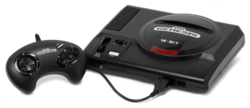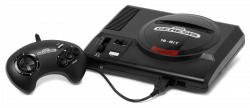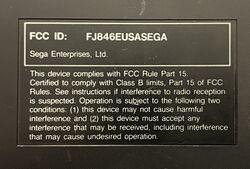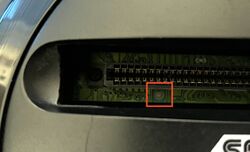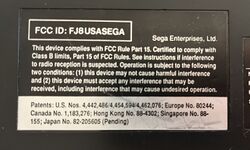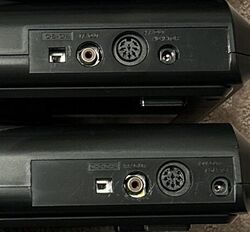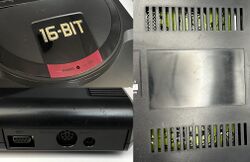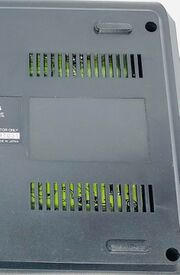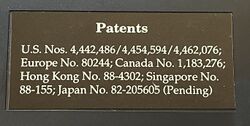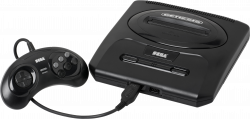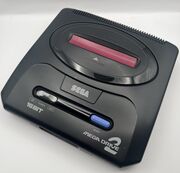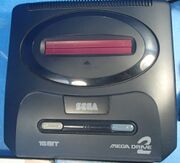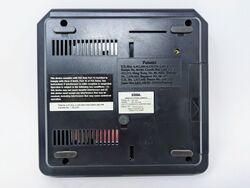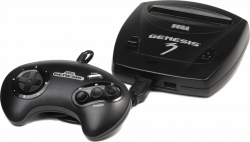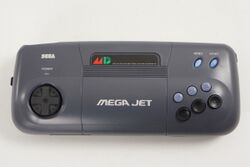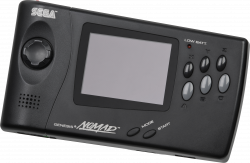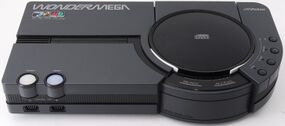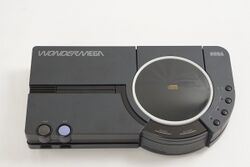Genesis:Buying Guide: Difference between revisions
| Line 173: | Line 173: | ||
| [[Image:Genesis Model 2.png|thumb|upright|250px|A model 2 Sega Genesis with 6-button controller.]] | | [[Image:Genesis Model 2.png|thumb|upright|250px|A model 2 Sega Genesis with 6-button controller.]] | ||
| [[Image:JPMegaDrive2.jpg|thumb|upright|180px|A Japanese Mega Drive 2. The Asian Mega Drive 2 is identical in appearance.]] | | [[Image:JPMegaDrive2.jpg|thumb|upright|180px|A Japanese Mega Drive 2. The Asian Mega Drive 2 is identical in appearance.]] | ||
| [[Image:HiComMD2.jpg|thumb|upright|180px|A later Korean Mega Drive 2.]] | |||
|} | |} | ||
Revision as of 02:35, 24 March 2024
Sega produced a wide variety of models and revisions of their 16-bit hardware, and it can be overwhelming for those who are looking to find the right console for their setup. This guide serves to delineate some of the major differences between these models, what they are capable of, and briefly explain what to look for in these consoles. Much of the inspiration behind this guide was taken from Ace's guide on Sega-16, which served as an excellent primer on the differences between Genesis models for many years. However, this guide will be constantly updated as new information arises and especially as new modifications are developed.
Standalone Models
Model 1
- Released in the following regions:
- Japan - October 1988
- North America - August 1989
- South Korea - 1990
- Asia - 1990/1991
- PAL regions (mainly Europe and Australasia) - 1990
- Brazil - 1990
- Rectangular in shape with a circular area surrounding the cartridge port
- Stereo audio is only available from the front headphone jack
- Outputs composite video, RGB and mono audio from a full-size 8-pin DIN connector
- French models only output RGB and require a special cable as the RGB output is unamplified
- Power input is a 5.5 x 2.1 mm barrel jack with tip negative polarity, expects 9V DC at 1.2 A
- All except French, Japanese and Korean models have RF output
- Asian, Japanese and Korean models have a cartridge lock mechanism which prevents cartridges from being removed while the console is powered on
- This same cartridge lock also prevents US or PAL cartridges from being played as they do not have a notch in the side for the lock
- Board revisions up to the VA6.5 have a 9-pin EXT port on the rear, which was only used in Japan for the Mega Modem add-on
- However, the EXT port is present in all Japanese models
- Power LED area is colored red on most models except PAL consoles, which have it in white
- "16-BIT" text is large and painted gold on Asian, Japanese and Korean models, small and silver on Brazilian and US models, and small and gold on PAL models
- Korean models were sold by (and later manufactured entirely by) Samsung as South Korea had heavy restrictions on Japanese consumer goods at the time. It was initially known as the "Super Gam-Boy" but was renamed as the "Super Aladdin Boy" in 1992
- Earlier models have "blurbs" silkscreened on the trim piece around the cartridge port area
- "AV Intelligent Terminal" and "High Grade Multipurpose Use" on Asian, Japanese and Korean models
- "High Definition Graphics" on North American models
- "High Definition Graphics - Stereo Sound" on PAL models
- All Brazilian models have the "High Definition Graphics" text, even later revisions
- Models with TMSS will have a bottom label listing various patent numbers
- In addition, North American models with TMSS have the FCC ID "FJ8USASEGA"
- The games Ishido: The Way of the Stones and Onslaught do not work at all on consoles with TMSS, as well as the US version of Populous and early copies of Zany Golf
- VA0 through VA2 board revisions have some audio distortion through the headphone jack as the preamp is slightly overdriven on these models. However, these can be easily modified to improve their audio quality by swapping some surface mount components on the underside of the board.
- VA0 through VA4 board revisions have subpar composite video which has "rainbow banding" across the entire screen. This is due to the video circuitry in these models and is not because of bad capacitors, as is often repeated across the internet. Later revisions reduced this but it is still present to a degree.
- VA3 through VA6.5 revisions require the least amount of work to get good quality audio and are fairly easy to find. Consoles without TMSS (VA3 through VA5) are generally favored as they have better game compatibility and boot straight into the game, but consoles with TMSS (VA6 and 6.5) can still provide a good experience.
- VA6.8 revisions, only released in PAL regions, also have good audio quality since they only differ from the VA6.5 in their video circuitry. However, they are considerably harder to find and since they are identical in functionality to the 6.5, there is no real benefit to seeking one of these out.
- The VA7 revision is not recommended in stock form due to its poor audio quality. If you are comfortable with soldering, a Triple Bypass or Mega Amp board can be installed to improve their audio to be on par with earlier models. Ironically though, they have what is probably the best video quality of the model 1s, with only minor jailbars over RGB and almost no "rainbow banding" over composite.
Board Revisions
Sega produced many revisions of the model 1, typically to either reduce production costs by consolidating chips, correct flaws from previous revisions, or both. For more information, see this page. Note that Sega used a slightly different board layout on non-Japanese consoles as they have an internal RF modulator.
| Photo | Revision Name | Date Range | Regions | TMSS | EXT Port | Notes |
|---|---|---|---|---|---|---|
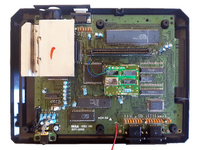 |
"VA0" | 1988 | Japan | No | Yes | Has an internal daughterboard that corrects the EDCLK signal. The headphone jack slider cap can be easily pulled off. The "VA0" name is not official, but is used to refer to this board in keeping with Sega's typical revision naming practices. |
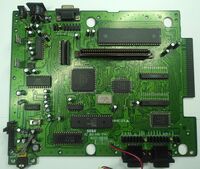 |
VA1 | 1989 | Japan | No | Yes | Has the 315-5339 EDCLK generator chip instead of the daughterboard and discrete 74LS00 chip featured on the VA0. No other changes. |
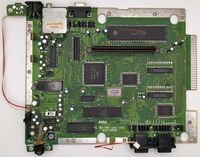 |
VA2 | 1989 | Japan and North America | No | Yes | First revision for North America. Nearly identical to the VA1 but changes out the 315-5339 with the 315-5345 chip. No other changes. |
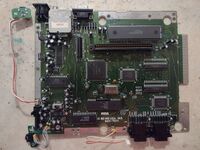 |
VA3 | 1989-1991 | Brazil and North America | No | Yes | First revision for Brazil. The 315-5308 and 315-5345 chips from the previous revision are combined into the 315-5364 I/O chip. Headphone preamp is no longer overdriven but has some low pass filtering added, making the audio slightly muffled but still very good. Video circuitry remains unchanged. This is the most common version of the US model 1 that does not have TMSS. |
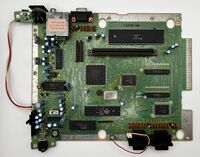 |
VA4 | 1989-1992 | Asia, Japan, Korea and PAL regions | No | Yes | First revision for Asia, Korea and PAL regions. Nearly identical to the VA3. PAL models with this board have the silkscreened text "High Definition Graphics - Stereo Sound" above the cartridge port. Video circuitry remains unchanged for Japanese models. PAL models have compatibility issues with the 32X, which can be fixed. |
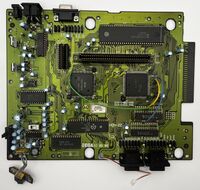 |
VA5 | 1990-1991 | Japan | No* | Yes | Consolidates the 315-5309 and 315-5364 chips into one I/O chip (315-5402). Has slightly improved composite video but audio quality remains the same. Has a compatibility issue with the 32X which can be fixed. * = Some VA5s have the TMSS screen only if the console is set to export mode via a region mod. When in Japanese mode, the TMSS screen will not appear. |
 |
VA6 | 1991-1992 | Asia, Brazil, Japan and North America | Yes | Yes | Identical to the VA5 but has an I/O chip with TMSS (TradeMark Security System) functionality, which adds the "Produced By or Under License from Sega Enterprises, Ltd" screen at boot. Certain games from Accolade and EA cannot be played beginning with this revision due to TMSS. Later Asian and Japanese VA6s lack the "AV Intelligent Terminal" blurb on the cartridge port area "ring". Starting with this revision, Brazilian model 1s were confusingly renamed the "Mega Drive II". This is the most common version of the US model 1 that has the "High Definition Graphics" text on the top shell. Has a compatibility issue with the 32X which can be fixed. |
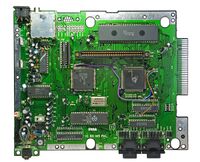 |
VA6.5 | 1992-1993 | Asia, North America and PAL regions | Yes | No | Completely identical to the VA6 but lacks the EXT port, and the rear panel has a large blank area where it once was. The "High Definition Graphics" blurb has been removed, and on most VA6.5s, the colored part of the "ring" surrounding the power LED is a separate trim piece and not painted on. The VA6.5 name originates from Sega service manuals and is not denoted on the board itself. This is the most common version of the PAL model 1. Has a compatibility issue with the 32X which can be fixed. |
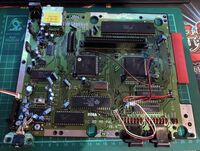 |
VA6.8 | 1993 | PAL regions | Yes | No | Almost identical to the VA6.5 but the video circuitry has been altered, as it uses a surface mount Fujitsu MB3514 video encoder instead of a through-hole Sony CXA1145. Seemingly very rare as few have been spotted. Final revision for PAL regions. Has a compatibility issue with the 32X which can be fixed. |
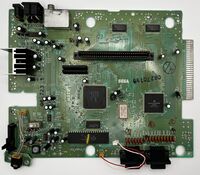 |
VA7 | 1992-1993 | Brazil, Japan, North America and Taiwan | Yes | Japan only | Complete internal redesign with most major chips consolidated into a custom ASIC, an increased use of surface mount chips and has a single 7805 voltage regulator instead of two. Video quality is improved over previous revisions. Has abysmal audio quality due to poor component choices in the audio circuitry (not because of the "audio chip" as is often repeated online), but can be corrected by modifications such as the Triple Bypass. On non-Japanese models, the rear ports have been shifted towards the center, making this model easily identifiable at a glance. This does not apply to Japanese VA7s as they still have the EXT port. This revision has major issues with being set to 50 Hz mode for PAL regions, and is likely why it was never used in PAL consoles. |
Model Numbers
| Model Number | Region | Notes |
|---|---|---|
| HAA-2510 | Japan, NTSC Asian | |
| 1601 | US | |
| 1601-22 | Canada | |
| 1600-03 | Australia | VA4 models |
| 1600-04 | New Zealand | VA4 models |
| 1600-05 | UK | VA4 models |
| 1600-09 | France | VA4 models, RGB only |
| 1600-10 | Mainland Europe | VA4 models |
| 1600-13 | Italy | VA4 models |
| 1600-18 | Germany | VA4 models |
| 1600-20 | Netherlands | VA4 models |
| 1600-24 | Scandinavia | VA4 models |
| 1601-03 | Australia | VA6.5 and VA6.8 models |
| 1601-04 | New Zealand | VA6.5 and VA6.8 models |
| 1601-05 | UK | VA6.5 and VA6.8 models |
| 1601-07 | PAL Asian | |
| 1601-09 | France | VA6.5 models, RGB only |
| 1601-11 | PAL Asian | |
| 1601-13 | Italy | VA6.5 and VA6.8 models |
| 1601-15 | China | |
| 1601-18 | Germany, Spain | VA6.5 and VA6.8 models |
| 1601-20 | Netherlands | VA6.5 and VA6.8 models |
| 1601-24 | Scandinavia | VA6.5 and VA6.8 models |
| SPC-200 / SPC-200R / SPC-200V | South Korea | |
| SPC-201R | South Korea |
Cosmetic Differences
Most board revisions can be identified without disassembly by examining certain areas of the console, as shown below.
Serial Number Ranges
Some model 1 revisions can be identified by the first three digits of their serial number. Note that this is a rough guide and there are some exceptions to these, such as case swaps. Therefore, it is best to use this guide in conjunction with the sections above to determine board revision. Brazilian consoles do not have serial numbers.
- VA0 (Japan only) = 88M, 98M
- VA1 (Japan only) = 89N, 89O, 99M, 99N
- VA2
- Japan = 39M, 89N and 99N
- North America = 39S through 39X
- VA3 = 39V, 39W, 30S through 30W
- VA4
- Japan = 80O, 80Q, 89O, 90O, 99O, A00, A10, B00, B10
- PAL = 110, 120, 40e, 41e
- VA5 (Japan only) = 80R, 80Y, A00, A10, B10, G10
- VA6
- Asia = A10, A20
- Japan = A10, A20, G11, G21
- North America = 020, 31S through 31X, A16, A26, B10, B20, G21
- VA6.5
- Asia = A20
- North America = 020, 030, 120, 320, A26, B20, G20, G30
- PAL = 120, 130, 220, 420, 430, A20, Q20
- VA6.8 (PAL only) = 130
- VA7
- Japan = A20
- North America = 020, 021, 030, 320, 620, B20, G20, R20
Model 2
- Released during 1993 in the same regions as the model 1
- Square in shape with a centered cartridge port
- No headphone jack
- Outputs composite video, RGB, mono audio and stereo audio via a 9-pin mini-DIN connector
- Power jack has been changed to an EIAJ-03 barrel jack (4.75 x 1.7 mm) with tip positive polarity, input voltage is the same but uses less current due to the model 2 having more power-efficient internals
- Later Brazilian models have an internal power supply with input voltage switchable between 110 and 220V
- All except Brazilian consoles use an external modulator for RF output
- Asian and Japanese models use a slide switch for power like the model 1, all others use a push button switch
- These models also lack a power LED
- Compatible with both Sega CD models, albeit with a very tight fit on the model 1 CD
- In the owner's manual, Sega recommended removing the rubber feet on the model 2 to get it to fit properly on the model 1 CD; there is also a notch next to each rubber foot so a flathead screwdriver can be slipped in to remove it
- 32X compatibility can vary between board revisions and 32X revisions[1], see the board revision guide below for more information
- Is still backwards compatible with Master System games, but the Power Base Converter does not fit as it was designed specifically for the model 1
- As with the model 1, Samsung manufactured and sold the model 2 in South Korea due to that country's import restrictions, where it was sold as the Super Aladdin Boy II. By 1997, Samsung exited the video game business and distribution rights were passed to HiCom, who sold it as the Mega Drive 2 with prominent Sega branding.
- VA0 through VA2.3 boards extend the entire width of the console, while the VA3 and VA4 only extend 3/4ths of the way, a difference which is visible through the bottom vents. This is the easiest way to determine if a model 2 will have good audio quality or not.
- VA0 through VA1.8 revisions have terrible audio quality, and depending on the video encoder chip used, can have poor composite video as well. RGB output is about as good as the VA7 model 1 regardless of encoder. However, while these are not recommended in stock form, they can be given better performance with some work. They can also be acquired very cheaply as they are in far less demand than the model 1 or VA3 and VA4 model 2s.
- For more information about the video encoder chips used in Genesis/Mega Drive consoles, check out this guide.
- To improve the audio quality on these models, a Triple Bypass board can be installed or some components can be changed out on the motherboard.
- VA2 and VA2.3 models are novel for having an actual YM2612, but their audio quality is lackluster without modification and composite video quality also varies depending on the encoder. The VA2 in particular has very noticeable jailbars over RGB. The VA2.3 also does not work properly with the 32X (unless a flash cart is used), and some use a buggy ASIC (detailed below).
- VA3s have fairly decent audio, but their video quality is also dependent on the encoder used. Models with a serial number beginning with 743, 753 or R43 are good bets as they will have a Sony encoder that provides better composite video. They also do not have compatibility problems with the 32X.
- Getting a VA4 is the only surefire way to have a model 2 with good video and audio quality, as the audio circuitry was largely unchanged from the VA3 and they will always have a Sony CXA1645 encoder (or an equivalent ROHM encoder in PAL regions). These are also some of the hardest to find as they were produced towards the end of the console's life.
- However, the 32X does not pair well with the VA4 and many 32X games will exhibit graphical glitching on this revision. However, this does not happen when playing 32X games on a flash cart. If you want to add a 32X to your setup and want to use original 32X carts, you may want to consider a VA3 instead.
- The power jack can often develop broken solder joints, preventing the console from powering on reliably, if at all. This is the most common problem with the model 2 and is easily fixed by reflowing the solder joints in question.
- Model 2 consoles are susceptible to having broken solder joints on the controller ports, and excessive pressure on the top case can cause the power LED to crack
- Bootlegs of the Asian and Japanese Mega Drive 2 are rampant on online marketplaces such as eBay, typically originating from eastern Europe. These are of very poor quality and should be avoided.
- This was the last version of the Genesis/Mega Drive hardware released in most parts of the world.
Board Revisions
For more information, see this page.
| Photo | Revision Name | Date Range | Regions | Notes |
|---|---|---|---|---|
 |
VA0 | 1993 | All Regions | Basically a condensed VA7 model 1 using much of the same components. Has compatibility issues with the VA0 32X unless the expansion port terminator piece is added. Has no compatibility issues with the VA1 32X. Arguably has the worst audio quality of the model 2 consoles. |
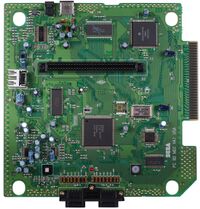 |
VA1 | 1993-1994 | All Regions | Similar to the VA0 but only uses a single RAM chip each for main RAM and video RAM. Some changes were made to resistors in the audio circuitry in an attempt to reduce audio distortion. Has no 32X compatibility issues. Final board revision for Japan. |
 |
VA1.8 | 1994-1996 | Asia, North America and PAL regions | Almost totally identical to the VA1, but some have wires going from the power jack's solder joints to extra solder pads on the board. Has no 32X compatibility issues. |
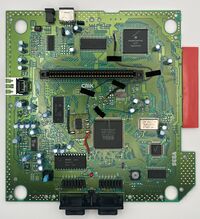 |
VA2 | 1994 | North America | Uses a different main ASIC (315-5786) manufactured by Toshiba which does not have an FM chip core. These instead have a discrete YM2612 FM chip like most model 1s. However, the audio quality is not the same as most model 1s and the FM audio is too loud relative to the other channels. VA2s have a small "bodge" board which is wired at several points throughout the main board. Largely found in Canada. Has no 32X compatibility issues. |
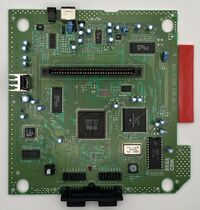 |
VA2.3 | 1995-1996 | North America | Similar to the VA2 but without the bodge board. Some of these have an ASIC with a buggy VDP core (315-5685), which causes odd graphical errors and ghosting as seen in the color bar test of the 240p Test Suite. Has some compatibility issues with both 32X revisions and both ASICs, which the extension port terminator cannot fix. However, these do not occur when loading 32X games from a flash cart. Consoles with this board have the model number "MK-1631A". |
 |
VA3 | 1994-1996 | North America | The first of the short board revisions. Has decent audio quality but composite video quality varies depending on the video encoder used. Has no 32X compatibility issues. |
 |
VA4 | 1996-1998 | Asia, Korea, North America and PAL regions | This is the first Genesis/Mega Drive to use a GOAC (Genesis On A Chip) ASIC, which combines all the main chips into one. North American VA4s can be discerned by small cutouts in the bottom RF shield, which are visible through the bottom vents. This distinction is irrelevant in Asian or PAL units since the VA4 was the only short board released in those regions. Composite video quality is decent and audio quality is slightly better compared to the VA3. Some US VA4s were sold by licensee Majesco, which can be determined by their different model number (MK-1451) and a white bottom label. Has compatibility issues with both 32X revisions, which the extension port terminator cannot fix. However, these do not occur when loading 32X games from a flash cart. |
Cosmetic Differences
Model Numbers
| Model Number | Region | Notes |
|---|---|---|
| HAA-2502 | Japan, NTSC Asian | |
| MK-1631 / MK-1631A | North America | The MK-1631A model number was only used for consoles which had a VA2.3 board |
| MK-1631-07 | PAL Asian, Russia | |
| MK-1631-08 | South Korea | Models sold by HiCom |
| MK-1631-50 | Europe, Australasia | Sega sold the same console across all of Europe and Australasia due to the model 2's use of an external RF modulator |
| SPC-1600R | South Korea | Super Aladdin Boy II |
| SPC-201N | South Korea | Super Aladdin Boy II |
Serial Number Ranges
Some model 2 revisions can be identified by the first few digits of their serial number. Note that this is a rough guide and there are some exceptions to these, such as case swaps. Therefore, it is best to use this guide in conjunction with the section above to determine board revision.
- VA0 = 030, 130, 131, 630, 730, A30, B30, G30, R30
- VA1 = 030, 130, 131, 230, 430, 630, 730, A40, AD41, B30, B40, G30, R30, R40
- VA1.8 = 040, 140, 151, 161, 240, 440, 450, 640, 740, A61, AD41, AD51
- VA2 = 240, 743, AD42
- VA2.3 = 162, 252, 452, 752
- VA3 = 163, 253, 463, 743, 753, R43
- VA4 = 164, 174, A74, A84, AG8, BF8
Genesis 3
- Released by Majesco in 1998, designed and engineered by Sega themselves
- The smallest of all Genesis/Mega Drive variants
- All were assembled in Mexico with PCBs being manufactured in Korea
- Uses the same AV and power connectors as the model 2, which are now on the left-hand side instead of the rear
- All Genesis 3 consoles output RGB in addition to composite video. The statement that it does not have RGB is a misconception which likely started with an inaccurate GameSX procedure.
- Has a wider cartridge slot which can accommodate most Japanese Mega Drive games
- Note that only Japanese Mega Drive games which don't check for region will work without modification. Japanese games made by Sunsoft will not fit.
- Only has mono audio, which is duplicated on the left audio pin of the AV connector for compatibility with stereo AV cables
- Stereo audio can be restored with a Triple Bypass modification
- Is totally incompatible with the Sega CD due to not having an expansion port, and is also incompatible with the 32X, Game Genie and Power Base Converter
- Flash carts which emulate the Sega CD (Mega EverDrive Pro, Mega SD) are compatible, but external audio will not work without modification
- There are only two board revisions, the VA1 and VA2. These can only be determined without a teardown by closely looking at the traces near the cartridge port. Unlike the model 1 and model 2, the serial number is an unreliable method for determining board revision
- The VA1 is largely similar to the VA4 model 2 and uses the same GOAC. It is the only Genesis 3 which can be modified for 32X or Master System support. If you are looking to acquire a Genesis 3, make it this revision if possible.
- The VA2 uses a different GOAC and cannot be modified for 32X or Master System support at all. Only Game Genie and Virtua Racing compatibility fixes can be performed on this revision.
- In addition, the VA2 fixes a TAS instruction in the 68000 CPU, which actually breaks compatibility with the game Gargoyles as it exploited this flaw.
- The VA2 is easy to identify internally as the GOAC chip is placed diagonally at the center of the board
- If you are only interested in playing Genesis games and do not care about expansions like the 32X or Sega CD, the Genesis 3 is an OK option. Fully modifying a VA1 revision with stereo audio and all the compatibility fixes almost places it on par with the other standalone models, but this involves delicate soldering and is not recommended for beginners. Buying a premodified console can also cost substantially more than a stock model 1 or 2, which all have stereo audio and do not have the same compatibility problems. If space is not a concern, consider a model 1 or good model 2 instead, even if you have no interest in 32X, CD or SMS games.
Handhelds
Mega Jet
- Only released in Japan
- Was initially made available in 1993 for rental on certain Japan Air Lines flights, then offered at retail on March 10, 1994
- Also sold under the Alpine car stereo brand; this version was marketed for use in vehicles
- Features 6-button controller functionality, headphone jack with volume control, and a controller port for a second player
- Is only semi-portable as it lacks a screen or the ability to take batteries, it has to be connected to a TV and plugged into a wall outlet
- Uses the same AV and power connectors as the model 2, and still has RGB output
- Is internally similar to the VA3 model 2, so audio quality is good
- Composite video quality is not quite as good as the better model 2s and is similar to older model 1s, with noticeable rainbow banding
- Has a fully wired cartridge port, meaning it is compatible with Master System games, external audio from flash carts, and the 32X
- Since it lacks an expansion port, it is not compatible with the Mega CD. CD games are still playable via flash carts such as the Mega EverDrive Pro and Mega SD.
- While the 32X can function on the Mega Jet, it doesn't actually leave enough room for the jumper cable to be plugged in, so a custom-built jumper must be used
- Even though it is highly compact, offers good performance and is a nice conversation piece, the Mega Jet's high price on the used market hampers it from being a practical choice. A VA3 or VA4 model 2 or even a modified Genesis 3 can offer more for just a fraction of its price if you want something on the small side.
Genesis Nomad
- Only released in North America and was sold beginning in late 1995
- The only version of the Genesis hardware that is truly portable, as it builds on the Mega Jet by adding an LCD screen and battery power
- Designed by both Sega of America and Sega of Japan
- Like the Mega Jet, it features 6-button controller functionality, a headphone jack with volume control and a controller port for a second player
- Also like the Mega Jet, it can connect to a TV and uses the same AV and power connections as the model 2
- Composite video is good but audio quality is average
- Takes six AA batteries which are loaded into a separate battery pack, adding even more bulk to the system
- Battery life is very poor in stock form due to the screen's fluorescent backlight, only around 2 to 4 hours with six alkaline AAs
- The stock LCD can be replaced with modern screen modifications, some of which use the composite video output, and some which use RGB; either option will provide superior image quality and vastly improved battery life
- If using the Nomad connected to a TV, it is recommended to use it with an AC adapter as the LCD does not shut off when an external display is connected
- Is incompatible with Master System games and the 32X; is obviously incompatible with the Sega CD
- Master System compatibility can be restored by adding a single wire from the main ASIC to pin B30 of the cartridge port. While 32X compatibility can theoretically be restored as well, the 32X physically blocks the AV out connector completely.
- External audio from flash carts is also not supported, but can be added through modification
- If you want to be able to play real Genesis cartridges on the go and want to use authentic hardware, this is literally your only option. However, the Nomad often sells for high prices and if you do not care about using real cartridges or original hardware for portable gaming, you might be better served by using emulation handhelds. The Nomad's poor battery life and blurry stock screen might also be off putting to some.
CD Combo Consoles
Soon after the release of the Sega/Mega CD add-on, Sega collaborated with electronics company JVC (known as Victor in Japan) to release consoles that combined both the Genesis/Mega Drive and CD add-on into a single unit. Later on, Sega would release a combination console themselves and also collaborated with Aiwa to release an odd boombox/game system hybrid.
All of these consoles were highly expensive when first released and as a result, sold in very limited numbers. Because of their rarity, they all still command high prices on the used market, especially the Japanese models. If you really want to be able to play CD games from actual discs and can afford their high price, these may be an attractive option over buying a standalone Genesis and CD add-on. However, their added complexity can hamper modifications and repairs, and service documentation for these models except for the X'Eye is lacking. In addition, all except for the Aiwa unit use a very particular 9.5 volt power supply that outputs 1.5 amps, using the same EIAJ-03 barrel jack connector as the model 2. Do not use a model 2 power supply with these as it cannot deliver enough current. A slim PS2 power supply or a Sony AC-FX150 are excellent alternative power supplies for these consoles.
Another important thing to note is these consoles cannot load CD games from flash carts such as the Mega EverDrive Pro or Mega SD, only cartridge ROMs. As of this writing, no ODE (optical drive emulator) exists for any of these consoles, so your only options for playing CD games are tracking down original discs or burning your own.
Sega/Victor Wondermega
- The first of the CD combo consoles, released in April 1992 in Japan only
- Was released under both the Sega and Victor brands, though both only have slight cosmetic differences
- The Sega unit has a white ring on the disc door and a black power button, the Victor unit has a black ring, white power button, and a sticker with both the Mega Drive and Mega CD logos
- Loaded with extra features such as S-video output, MIDI out, two microphone inputs for karaoke, and DSP audio effects
- The disc door is motorized and can open or close automatically via the controller
- Has a spring-loaded cartridge lock which prevents US/PAL cartridges from fitting
- This was the first ever Genesis/Mega Drive console to use an ASIC in place of the VDP, FM chip and I/O
- Does not have RGB output, only composite video and S-video
- RGB mods exist which replace the RF modulator connector with the model 2's 9-pin mini-DIN connector
- The 32X does not work due to the lack of RGB out, and the "lip" on the bottom of the 32X prevents it from fitting on the Wondermega
- This is essentially the "Rolls-Royce" of Genesis/Mega Drive consoles because of all the additional features it offers. Fittingly it also has a very high price tag on the used market, putting it out of reach for most. The extra features also mean that the chance of something failing is higher; the motorized disc door in particular is driven by a rubber belt which could become overstretched with age.
Victor Wondermega M2
- Cost-reduced redesign of the Wondermega, released in 1993 for Japan only
- Was sold with an infrared 6-button controller which can remotely turn on or reset the console, and doubles as a basic TV remote
- Power button is a momentary switch
- Removes MIDI out, most of the DSP audio effects (except for an echo effect on the microphone inputs), and the motorized disc door
- Still has S-video out but no RGB
- Victor provided a modification service which would add RGB output for 32X compatibility
- RGB mod kits also exist that replace the RF modulator output with the model 2's 9-pin mini-DIN
- The controller ports are at the rear to make room for the IR receiver at the front
- These are slightly easier to find than the original Wondermega, but are still rather pricey. These also have issues with leaky surface mount capacitors and need to be serviced if they haven't been already. Only purchase one that has been serviced or if you are comfortable performing this kind of work.
JVC X'Eye
- The North American version of the Wondermega M2, released in the spring of 1994
- Has less features than even the M2; the S-video out, IR receiver, DSP effects, headphone volume control and one of the microphone inputs have been removed
- Controller ports have been moved to the front in place of the IR receiver, and the console came with a JVC-branded version of the wired Sega 3-button controller
- Most have the 9-pin mini-DIN connector from the model 2 Genesis, adding RGB output and 32X compatibility; these are in addition to discrete RCA jacks for composite and stereo audio
- Older X'Eyes do not have the mini-DIN, but all have the internal footprint and solder pads for one
- Power button is a push button switch like the model 2
- The 32X normally blocks the disc door, so it must be removed before inserting or removing a disc
- JVC offered a service where owners could have their console modified with a different disc door, which allowed for it to fully open with an attached 32X
- 32X game compatibility is spotty on both 32X revisions
- Because the cartridge port opening was not changed from the M2, all Japanese Mega Drive games will fit
- Japanese carts will also work fine if they do not perform a region check
- Master System games will work with a cartridge adapter but not through a flash cart
- If you are searching for a CD combo console, this is arguably the one to have. It is not as complex as the Wondermega consoles, does not have capacitor issues like the M2, and service documentation is also available on the internet (including this very wiki). The laser is also shared with some model 2 Sega CDs and most Sega Saturn consoles, and replacement lasers are easy to find. Its price is still rather high though since it originally sold for US$499 in 1994 and was made in limited numbers.
Genesis CDX/Multi-Mega
- The only CD combo console released in all major regions
- Released in early 1994
- Sold as the Genesis CDX in North America and as the Multi-Mega in Europe, Brazil and Asia
- In Japan, the CDX was sold by the global language training company Linguaphone as the "Education Gear", and was marketed as an educational tool
- The smallest of all the CD combo consoles by far, is only slightly larger than a Genesis 3
- Can double as a portable CD player
- Compatible with both the 32X and Power Base Converter
- Uses the same AV connector as the model 2 and the same power supply as the JVC/Victor consoles
- Both RGB and composite video are decent but slightly noisy
- Has average audio quality
- Games which extensively use FMV may have playback issues
- The CDX is a very appealing option due to its small size, but that small size comes at a price in more ways than one. Working examples can command a higher price than the X'Eye, and the small size makes it fairly difficult to service as all the internal hardware is very tightly packed. If you have the budget, make sure to get one that is in good working order. Replacement lasers are also tough to find despite being shared with some 3DO and Saturn consoles.
Aiwa Mega CD
- A bizarre combination of a boombox, Mega Drive and Mega CD, only released in Japan in 1994
- The Mega Drive/Mega CD portion is a separate piece which connects to the boombox via a DB25 cable, which interfaces it to power and the boombox's CD drive
- Came with a blue Aiwa-branded 3-button controller
- Uses the model 2 mini-DIN for AV out
- Mega Drive portion is equivalent to a VA3 model 2
- Is compatible with the 32X and Master System games, but the front-mounted cartridge port means caution must be taken with the 32X
- This is by far the rarest of the combo consoles and often sells for thousands of dollars. Best left as a collector's item.
PC Combo Consoles
During the early 1990s, two different systems were released which combined an IBM-compatible PC and a Mega Drive system into a single unit. Neither one performed well in their respective markets due to their high retail prices and lackluster specifications for the time. None of these are practical choices as either a Genesis/Mega Drive or DOS PC and are best left as collector's items.
TeraDrive
- Released in 1991 in Japan only
- The product of a collaboration between IBM Japan and Sega
- Slim desktop form factor PC with an integrated Mega Drive
- Cartridge slot, controller ports, headphone jack and two PS/2 ports are at the front, all other I/O is at the rear
- PC portion uses a 10 MHz 286 CPU
- Mega Drive expansion port is hidden behind a panel on the top
- Has a single 16-bit ISA expansion slot
- Three models were produced with different configurations:
- Model 1 - 640 KB RAM, one 3.5" floppy drive
- Model 2 - 1 MB RAM, two 3.5" floppy drives
- Model 3 - 2.5 MB RAM, one 3.5" floppy drive and 30 MB hard drive
- Both the Mega Drive and PC portions can interact with one another and can be active simultaneously
- The Mega Drive portion has TMSS with a unique boot screen
- As a DOS PC, there are much more powerful and far less expensive choices around, as the TeraDrive is hampered by its 286 CPU and has very limited room for expansion cards. It is also very limited as a Mega Drive console since its size and form factor prevents the use of the 32X and CD.
Amstrad Mega PC
- Released in 1993 in Australia and Europe as a collaboration between Amstrad and Sega
- Bundled with a multisync 15/31 kHz monitor
- PC portion uses a 25 MHz 386 CPU
- The Mega Drive and PC portions are independent of each other
- A sliding door covers up either the Mega Drive cartridge slot or floppy drive depending on what portion is in use
- Has two 16-bit ISA expansion slots, but one is occupied by an 8-bit ISA card containing the Mega Drive hardware
- Came with 1 MB RAM, a single 3.5" floppy drive and a 40 MB hard drive
- The Mega PC is slightly more useful as a DOS PC due to its 386 processor, but also has limited expansion capabilities. The Mega Drive portion also has the same limitations as the TeraDrive's.
Notable Clone Consoles
Analogue Mega Sg
- Uses an Altera Cyclone V FPGA to emulate the Genesis hardware and can use original cartridges
- It can also emulate the Master System, Game Gear, and SG-1000
- Roughly the same size as a Genesis 3
- Available in five different colorways:
- USA (red power button and gray reset button)
- EU (white power button and gray reset button)
- JP (red power button and blue reset button)
- all-white
- Hyperdub x Analogue Limited Edition (only 1,000 produced, has transparent case with clear yellow power and reset buttons)
- Outputs 1080p digital video through HDMI and uses a micro USB port for power
- Is compatible with most Genesis and Master System accessories
- Came bundled with an adapter for Master System cartridges, and Analogue also sold adapters for Game Gear carts, Sega Cards, and SG-1000 and Mark III carts
- Also has an expansion port so it can connect to a CD add-on, and has a 3.5 mm audio output jack at the front for audio mixing into a Sega CD
- Is compatible with the 32X, but requires Analogue's DAC and special cables
- This is because the 32X only accepts analog RGB input and the Mega Sg has no analog video output without using the DAC
- Has an SD card slot which is officially used for firmware updates, but with jailbroken firmware it can load game ROMs from this slot like a flash cart
- Jailbroken firmware also adds compatibility with ColecoVision ROMs, as that console used the same hardware as the SG-1000
- Can emulate both the YM2612 and YM3438 core used in later Genesis consoles
- Is completely region-free
- If using original hardware is not that important and you want to play all original 8-bit and 16-bit Sega games on both cartridges and CD, this is the console to get. It is also extremely easy to integrate into a modern setup since it has HDMI and is powered via USB. However, it was discontinued in early 2023 and Analogue has no plans to produce more. As a result, it often sells for over US$400 on the used market. Continued support from Analogue is also in question as they issued few firmware updates over its life.
AtGames Classic Gaming Console
- Produced by AtGames and officially licensed by Sega
- First introduced in 2009
- Has a cartridge port for compatibility with original Genesis cartridges and also features a number of built-in games
- Very small form factor and is slightly smaller than even a Genesis 3
- Came bundled with infrared 6-button controllers but also has two controller ports
- Uses the emulation-based "Firecore" architecture used in many AtGames systems
- Emulation accuracy is extremely poor, especially in regards to sound
- Only outputs composite video and mono audio
- Is incompatible with the 32X, Sega CD and Power Base Converter
- These miniscule consoles may look appealing, but they exhibit very poor build quality along with equally poor emulation. Avoid.
AtGames Flashback
- Released in 2017 by AtGames
- Can use original Genesis cartridges and also has built-in games
- Uses a Linux-based system on a chip (SoC) running a version of the Genesis Plus GX emulator
- Emulation accuracy is improved over the older Firecore consoles, but the hardware does not have enough processing power to run the emulator at full speed some of the time
- Outputs 720p digital video over HDMI
- Has a basic scanline filter, a "rewind" feature and save state support
- Does not read cartridges directly and instead loads the ROM file into memory
- This causes problems with official multicarts such as the 6-Pak as it reads the menu and each game as separate ROMs
- Has a power backfeed issue where the power LED comes on with just the HDMI cable connected
- While AtGames put in more effort with this console, it still has significant shortcomings. Not recommended. It is worth noting that after this console, Sega ended their licensing deal with AtGames.
Hyperkin Mega Retron HD
- Released in 2018
- Not licensed by Sega
- Resembles a model 1 console
- Unlike the AtGames consoles, this uses a GOAC chip and has much better compatibility as a result
- Outputs both 720p HDMI and composite video, is powered through a micro USB connector
- A switch on the rear of the console can change the HDMI output's aspect ratio to 4:3 or 16:9
- Unlike the Mega Sg and Flashback, this does not output true digital video as it is RGB being put through an internal HDMI converter
- Is region-free and has a switch on the bottom to select between different region modes
- The GOAC even has two different clock crystals so it can output true NTSC or PAL video
- Is compatible with Master System games, but they do not display correctly in US or JP region modes through HDMI, and the internal HDMI converter also does not scale them properly in PAL mode
- Is not compatible with the 32X or Sega CD at all
- This has decent performance for an inexpensive clone console and is a very cheap way to play original Genesis cartridges on a modern TV. That being said, the internal HDMI converter used in this console is of average quality, has a rather soft picture and does not have any additional features beyond an aspect ratio switch. The fact that it has composite video means it can be connected to a CRT or even a far superior HDMI upscaler such as a RetroTINK, but at that point it is better to go with an original Sega console.
References
https://segaretro.org/Sega_Multi-Mega
https://en.wikipedia.org/wiki/Sega_Genesis
https://www.retrorgb.com/genesisversions.html
https://gametrog.com/sega-cdx-information-specs/
https://segaretro.org/Sega_Mega_Drive/Hardware_revisions (board pics)
https://gametrog.com/sega-genesis-1-2-3-information-specs/
https://retroconsoles.fandom.com/wiki/Sega_Mega_Drive/Genesis
https://www.sega-16.com/forum/showthread.php?27397-VA2-Preamp-fix
https://www.sega-16.com/forum/showthread.php?22892-Sega-Genesis-Mega-Drive-Manufacture-Date-Registry
https://www.sega-16.com/forum/showthread.php?7796-GUIDE-Telling-apart-good-Genesis-1s-and-Genesis-2s-from-bad-ones (invaluable info)
https://medium.com/rgb-inside/comparing-native-rgb-video-quality-of-different-models-of-mega-drive-and-sega-genesis-english-e3d3703270ba (video output info + other variants)
https://www.reddit.com/r/SEGAGENESIS/comments/j6qg7k/sega_genesis_models_1_2_3_sound_question/
https://www.reddit.com/r/SEGAGENESIS/comments/biueke/gensis_va2mega_drive_va02_preamp_fix/
